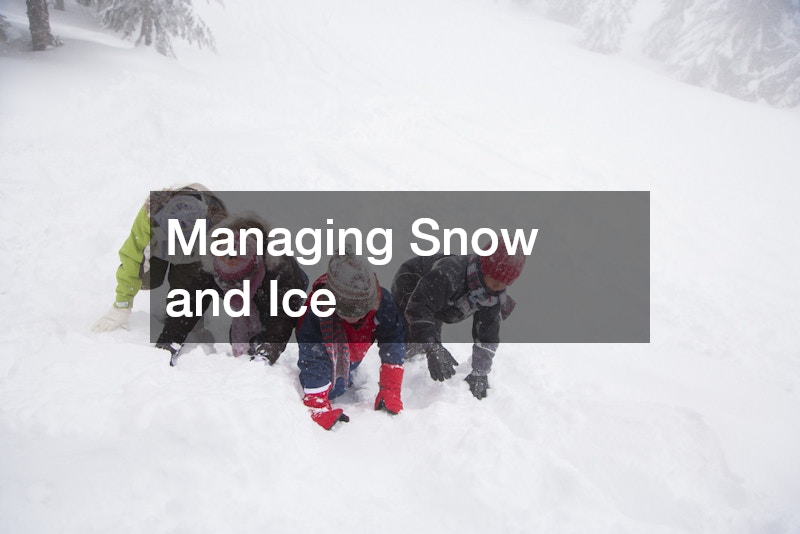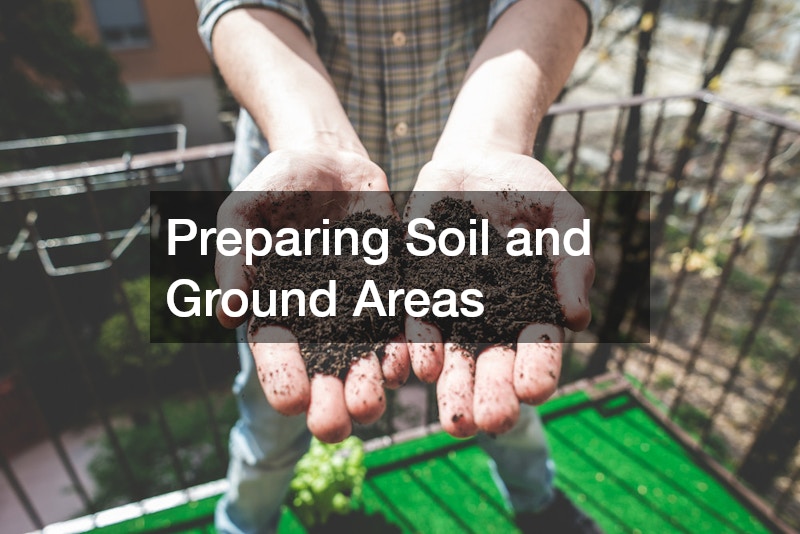Preparing your property before harsh temperatures, icy conditions, and snowfall arrive is essential to maintaining its structural integrity and preserving value. As the seasons shift, exterior winter challenges can place stress on everything from landscaping and roofing to outdoor equipment and driveways. Understanding what needs attention and why those preparations matter allows homeowners to create a thoughtful, effective maintenance plan. Proper planning helps avoid costly repairs, increases safety, and ensures your outdoor spaces transition smoothly into spring. The key to successful preparation is approaching the process systematically—looking at landscaping, structures, equipment, and traffic areas with both prevention and long-term upkeep in mind. The goal is to minimize seasonal risks while creating a protective buffer that withstands winter’s demands.
Protecting Trees and Shrubs
Exterior winter conditions can make trees and shrubs vulnerable to breakage, drying, and stress, especially when temperatures fluctuate or ice accumulates. As part of seasonal preparation, evaluating the health and structure of your property’s plant life is essential. Addressing potential problems early prevents damage and helps maintain visual appeal when spring returns. A professional tree trimming service can shape branches to reduce wind resistance and remove weak limbs that could snap under the weight of snow. This type of pruning is especially helpful for trees that overhang walkways, roofs, or driveways where falling branches could cause injury or property damage.
Soil moisture is another important factor that influences cold-season plant resilience. Since roots continue to function even when foliage has gone dormant, ensuring consistent hydration before deep ground freezes can support sustained root health. Applying mulch around the base of shrubs helps retain warmth and moisture while shielding roots from harsh temperature swings. Winter watering should be done before the first deep freeze so the soil can absorb and hold adequate moisture.
Young trees and delicate shrubs may need additional protection. Wrapping trunks with breathable tree wrap or burlap shields bark from cracking and reduces exposure to wind burn. For evergreens in particular, excessive wind can strip moisture and cause browning. Barriers such as burlap screens act as a windbreak and help retain natural oils that maintain vibrant foliage.
Evaluating the condition of trees and shrubs annually is not just a cosmetic concern. Strong, well-maintained plant life supports your landscape’s structure, enhances privacy, and helps prevent soil erosion. By investing time into seasonal care, you safeguard a living component of your property that contributes both beauty and long-term environmental value.
Managing Snow and Ice
Exterior winter weather often brings heavy snow accumulation and icy surfaces that can make both movement and maintenance difficult. Preparing for these conditions ahead of time helps ensure your property remains accessible and safe throughout the season. Working with professional snow removal services can provide peace of mind when storms arrive quickly or repeatedly. These services often monitor weather patterns and schedule plowing or clearing efficiently, reducing the risk of ice buildup from compacted snow.
Homeowners can also take steps to prepare driveways, patios, walkways, and stairs for winter weather. Applying a sealant to concrete or masonry surfaces helps prevent moisture penetration, which reduces the risk of cracking from repeated freeze-thaw cycles. Removing leaves, twigs, and other debris before the first snowfall decreases the likelihood of slippery surfaces forming when wet organic matter adheres to pavement.
Salt and ice-melt products can make surfaces safer, but must be used thoughtfully. Overuse can harm plants, corrode metal railings, and wear down concrete. Alternatives such as calcium magnesium acetate or sand can provide traction while minimizing environmental impact. If you plan to use traditional salt, applying it sparingly and sweeping up residue when temperatures warm can help extend the life of your property’s surfaces.
Outdoor drainage should also be evaluated prior to winter weather. Clogged gutters or blocked downspouts can lead to ice dams, which may cause water to seep into roofing materials or indoor walls. Clearing gutters, adding extensions to direct water away from the foundation, and checking grading around the home all play an important role in winter safety and property protection.
The goal of snow and ice management is not only convenience but also prevention. Keeping surfaces clear helps minimize risk of accidents and preserves the condition of high-traffic outdoor areas.
Supporting Landscape Structure
Exterior winter stress affects the entire landscape, making preparation a multi-layered process. Landscaping contractors can help evaluate planting beds, retaining walls, and border structures for signs of wear or soil movement. Ensuring that edges, barriers, and raised features remain secure keeps your yard organized and prevents shifting that often occurs during freeze-thaw cycles. Mulching garden beds and insulating root zones support plant health throughout dormancy.
Hardscape elements, including paver pathways, patios, and retaining walls, benefit from seasonal reinforcement. Repositioning shifted stones, cleaning out joints, and adding stabilization materials where necessary can prevent larger repairs later. Landscape fabric and gravel drains are frequently added or replaced before winter to keep water from pooling in unwanted areas.
Irrigation systems require special handling as temperatures drop. Any water left inside irrigation lines can freeze, expand, and cause cracks or ruptures. Draining and winterizing irrigation components protects both underground tubing and exposed fixtures. Sprinkler heads and drip lines should be cleared, valves closed, and control systems placed in standby mode until spring.
Shrubs and perennials that rely on soil depth for insulation may need additional protection during particularly cold seasons. Burlap screens, raised beds, or frost blankets can help regulate temperature around sensitive planting zones. Properly covering but not smothering plants prevents mildew and retains necessary airflow.
Landscape structure plays a major role in long-term seasonal resilience. Maintaining strong foundational elements helps ensure that your outdoor spaces remain stable, attractive, and functional when the cold season arrives.
Preparing Soil and Ground Areas
Exterior winter preparation extends to soil conditions and ground composition. Heavy precipitation, snowmelt, and foot traffic can compact soil, which restricts root growth and water movement in spring. Compaction equipment rentals can be used strategically in fall to loosen soil before winter dormancy, promoting strong root development when growth resumes. Aeration is particularly valuable in high-traffic lawn areas or where vehicles and equipment frequently pass.
Once the soil has been aerated, adding compost or natural amendments can improve nutrient levels and support microbial activity during colder months. While plant growth slows significantly during winter, beneficial organisms continue to function beneath the surface. Providing organic material enhances soil fertility and helps prepare garden and lawn areas for robust spring growth.
Raised beds, decorative borders, and plant islands benefit from reshaping and edging before winter weather. Cleaning out dead plant material, removing weeds, and turning the soil lightly can reduce the risk of pests and fungal growth when snow blankets the garden. Cover crops, such as winter rye or clover, can also be planted to stabilize soil and replenish nitrogen levels naturally.
Ensuring proper drainage prevents serious problems when snow begins to melt. Identifying areas where water tends to pool and creating runoff paths helps protect both the lawn and structural features. Grading, trenching, or adding drainage channels may be necessary in areas with persistent moisture accumulation.
Taking time to prepare soil and ground areas reinforces the foundation upon which your landscaping depends, ensuring healthier and more resilient growth when warm weather returns.
Maintaining Outdoor Equipment
Exterior winter conditions require dependable equipment to manage snow and protect property. For individuals who handle seasonal maintenance directly, checking the condition of snowplow equipment is essential to ensuring it performs when needed. Blades, hydraulic systems, mounting attachments, and electrical controls should all be inspected before the first snow event. Lubricating pivot points and examining lines for wear can prevent breakdowns during demanding conditions.
Truck accessories also contribute to winter readiness. For example, a truck bed cover can help protect tools, emergency supplies, and materials from snow and ice. Weatherproof covers prevent accumulation and make it easier to transport salt, sand, shovels, or safety equipment as needed. Ensuring that covers are secure and in good condition helps maintain access and protects equipment from corrosion or moisture damage.
Outdoor power tools, including snow blowers and chainsaws, should be cleaned, serviced, and tested before winter weather sets in. Fuel stabilizers can prevent engine problems, while blade sharpening and belt inspections ensure efficient performance. Storing tools in a dry, covered location reduces exposure to moisture and temperature swings, extending their lifespan.
Homeowners who prefer professional help should schedule equipment servicing early. Demand increases sharply once winter weather begins, making it more difficult to get timely repairs. Preparing equipment ahead of the season assures that you are ready to respond effectively to snow accumulation whenever necessary.
Reliable equipment plays a critical role in maintaining access and safety throughout the winter season. Preventive servicing helps protect both your property and your peace of mind.
Caring for Lawn Health
Exterior winter temperatures may send lawns into dormancy, but preparation before that point shapes how well they recover in spring. Many lawn care companies recommend late-season fertilization to provide essential nutrients that support root strength during the dormant period. Slow-release formulas nourish grass over time, helping it remain resilient against cold damage.
Leaf and debris removal before snowfall is also critical. When leaves become trapped under accumulating snow, they retain moisture that encourages mold and fungal diseases. Clearing lawns thoroughly not only promotes air circulation but also reduces the risk of lawn thinning or patchiness in spring.
Aeration is another key component of lawn health preparation. Allowing air and water to circulate through the soil encourages strong root systems that store energy during winter. When paired with overseeding, aeration helps fill in thin areas, resulting in a denser, more vibrant lawn when temperatures rise again.
Winter can be especially harsh on lawns that see frequent foot traffic. Designating walkways and minimizing movement across grass when snow or ice is present prevents compaction that can choke root systems. Installing temporary stepping paths or redirecting activity to hardscape features may protect vulnerable lawn areas.
Watering just before the ground freezes ensures that the grass has adequate hydration going into dormancy. This helps prevent winter desiccation, especially in areas where snowfall is minimal. By meeting these foundational needs, homeowners help create conditions where lawns rebound quickly and thrive in warmer months.
Addressing Hazard Trees
Exterior winter storms combined with freezing winds can create hazardous conditions for aging or weakened trees. Before winter arrives, assessing whether trees present a risk to structures, vehicles, or walkways is a crucial safety step. Consulting professionals who specialize in local tree removal services ensures that dangerous trees are managed responsibly, particularly when decay or structural instability poses potential threats.
Working alongside arborists can provide valuable insight into the long-term health of your property’s tree population. These experts evaluate not just visible structure but also disease, root conditions, and growth patterns that influence stability. Removing only what is necessary protects the landscape’s natural character while reducing liability risks.
When hazardous limbs are identified, targeted removal helps prevent breakage during storms. Trees that lean toward homes, power lines, or high-traffic areas may need reinforcement or selective trimming. In some cases, cabling or bracing can prolong the safe life of a tree that still contributes positively to the property’s landscape.
Winter storms often arrive unexpectedly, making early action essential. Taking time to identify and mitigate hazards before severe weather ensures that your property remains safe and structurally sound throughout the season.
Relocating or Preserving Trees
Exterior winter planning sometimes includes the strategic repositioning of large plants or young trees. When a tree has outgrown its current location or conflicts with a planned landscape improvement, a professional tree relocation service can move it safely and effectively. Relocation protects the value of mature trees and supports long-term landscape design goals.
Timing matters when moving trees. Late fall, just before deep dormancy, is often ideal for relocation because root systems are less active and transplants experience less shock. Proper soil preparation, hydration, and stabilization at the new site help ensure survival and future growth. After relocation, insulating the base and securing support systems helps the tree withstand winter conditions.
In addition to moving trees, this is a good time to apply winter protection strategies to delicate or newly planted species. Wrapping trunks, applying anti-desiccant spray, and installing windbreaks can all contribute to healthier growth when spring returns.
This final section includes one additional use of the phrase exterior winter to complete the required frequency. Ensuring that large plant life is preserved, protected, and strategically positioned strengthens the long-term health and beauty of your property, even in harsh seasonal conditions.







